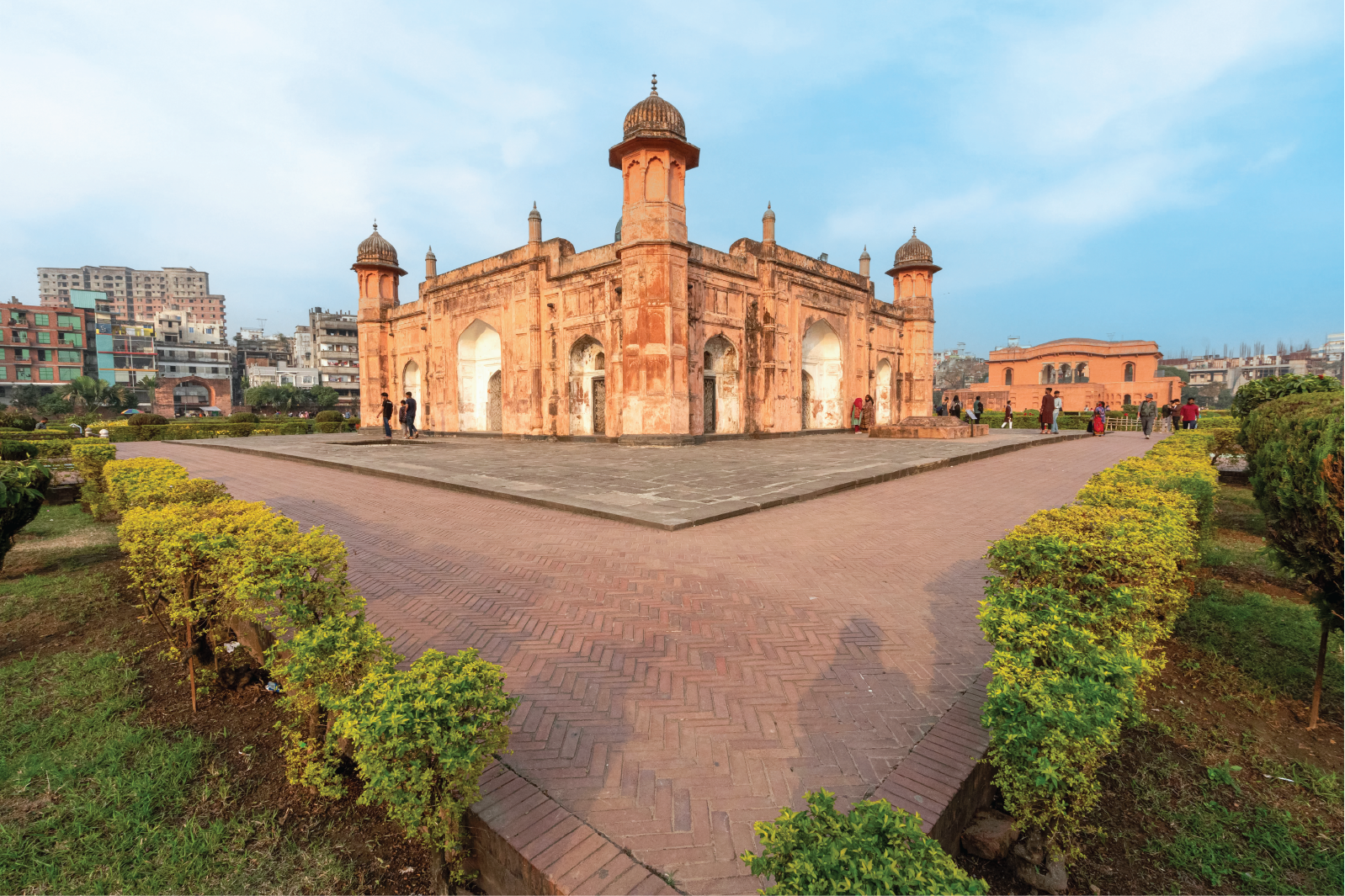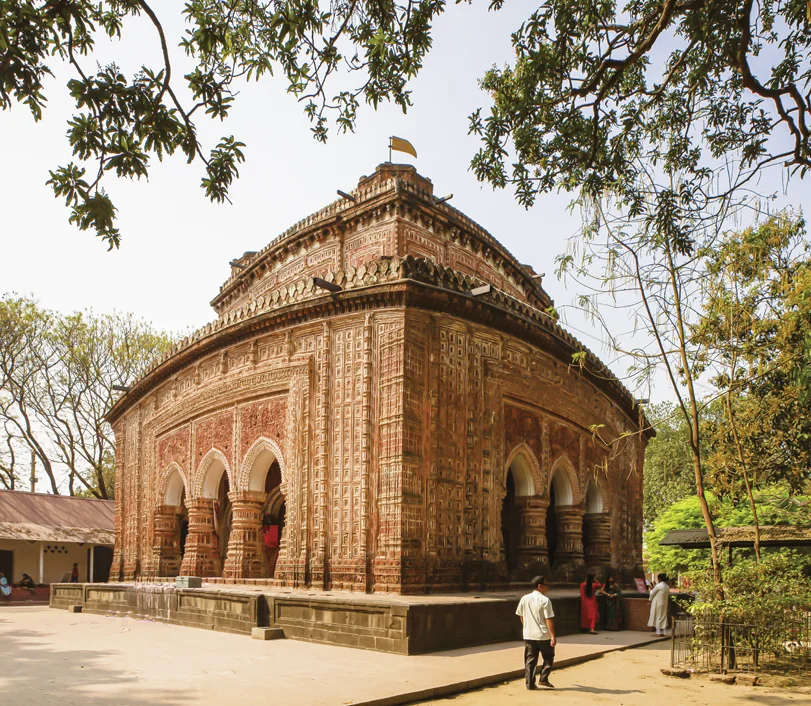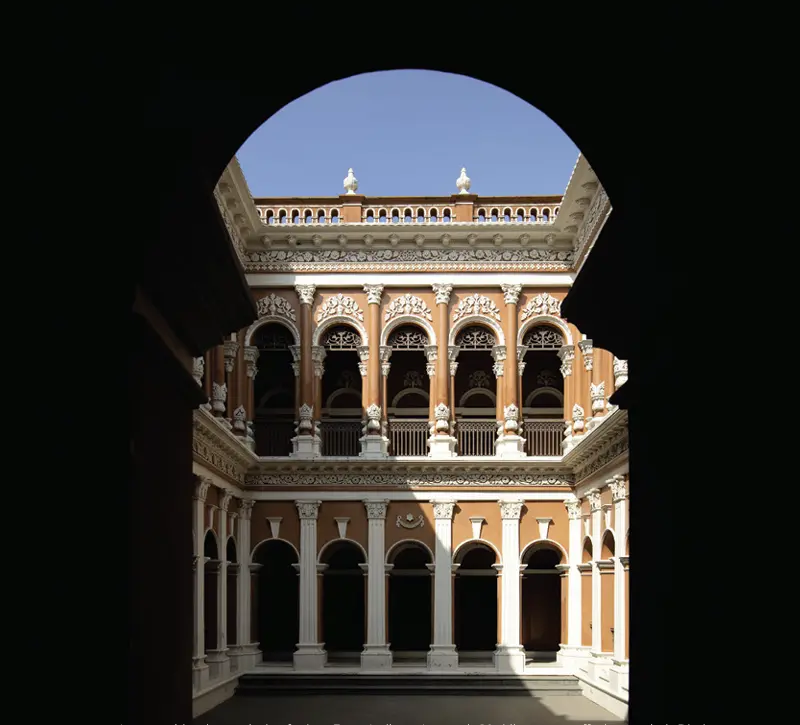
Lalbagh Kella is perhaps the most quintessential remnant of the Mughal era in Bangladesh. Also known as Lalbagh Fort or Fort Aurangabad, it is a majestic historical site located in the heart of the old town of Dhaka. Built during the 17th century, Lalbagh Fort is a testament to the grandeur of this region’s rich history. Commissioned by Prince Muhammad Azam, the third son of Emperor Aurangzeb, it is also one of the most renowned Mughal structures in the subcontinent. Although Prince Azam initiated its construction, it was left incomplete due primarily to untimely death of his beloved wife, Pari Bibi. Iran Dukht Rahmat Banu, more known as Pari Bibi, was the daughter of Shaista Khan and grandniece of Nur Jahan, the consort of the Mughal Emperor Jahangir. Prince Muhammad Azam’s dream of creating a magnificent fort was left incomplete due to his wife’s untimely death and his own departure to join his father’s military campaign. This poignant episode in the prince’s life is an integral part of the fort’s history. The incomplete status, frozen in time, grips the guests within an aura of wonder about what it might have looked like had it been finished.

In 1678, Mughal Prince Muhammad Azam Shah embarked on the construction of Lalbagh Fort along the bank of Buriganga in the southwestern part of Dhaka city. At the time, he held the position of Subedar (Provincial Ruler) of Bengal. However, his tenure in Bengal was only 15 months. His father Emperor Aurangzeb called him to Delhi to suppress the Maratha rebellion. Despite this setback, significant progress had been made, including construction of a mosque and the Darbar Hall. In 1680, Shaista Khan assumed again the role of Subedar of Bengal and took up the mantle of completing the fort. Under his guidance, the construction resumed. However, tragedy struck when Shaista Khan’s daughter, Pari Bibi, passed away prematurely within the fort in 1684. Grief-stricken, Shaista Khan deemed the fort is inauspicious and halted further construction, leaving it forever incomplete and abandoned.
Shaista Khan ruled Bengal in Mughal period for a total of 22 years, from 1664 to 1678 and from 1680 to 1688. He was the maternal uncle of Emperor Aurangzeb. During his reign Dhaka prospered greatly and the best period of Mughal rule passed. He built Chota Katara Mosque and Seven Dome Mosque near Lalbag fort. Chittagong victory is one of his notable achievements. He also defeated the British in the Anglo-Mughal war. The architecture of the fort reflects the distinctive style, characterised by its typical grandeur, symmetry, and meticulous attention to ornamented details. Built primarily with brick, it showcases the finesse of Mughal-era craftsmanship. The fort’s main gateway is a three-story structure that embodies the classic Mughal arch. The gateway features ornate floral motifs and Quranic inscriptions, a sublime fusion of Islamic art and architecture. With its symmetrical design and elegant arches, the southern gate of the fort is another splendid example of Mughal architecture. The fort is adorned with massive corner towers, each with a distinctive style. These towers served both decorative and defensive purposes, and they provided an excellent vantage point to appreciate the entire site and its surrounding landscape.

Tomb of Pari Bibi: A Testament to Love and Tragedy
The tomb of Pari Bibi stands as one of the three primary structures within Lalbagh Fort — a silent witness to love, loss, and architectural beauty. In 1684, tragedy struck when Pari Bibi, the beloved wife of Prince Muhammad Azam and daughter of Subedar Shaista Khan, passed away prematurely. Her final resting place became the under-constructed Lalbagh Fort, where a tomb was erected to honour her memory. As visitors enter through the main gate of Lalbagh Fort, Pari Bibi’s tomb immediately captures their attention. In fact, the iconic image associated with “Lalbagh Fort” is none other than the exquisite tomb of Pari Bibi herself. The tomb boasts a quadrangular design, crafted from pristine white marble adorned with delicately carved screens and intricate floral motifs. Inside, nine rooms reveal a symphony of materials: marble stones, rough stones, and glazed tiles adorned with colourful flowers and leaves.
The central chamber houses Pari Bibi’s burial site, surrounded by eight additional rooms. Among them, the southeast room cradles another small tomb — the resting place of Pari Bibi’s daughter, Samsad Begum. The tomb’s roof, fashioned in the corbel style, features four octagonal minarets at the corners and a central octagonal dome. Once gilded, the dome now wears a covering of brass and copper sheets. The interior, too, gleams with white marble stones. This 20.2-square-meter tomb was constructed before 1688 AD, but fate had other plans. After Subedar Shaista Khan’s departure from Dhaka, the fort lost its significance, eventually falling into abandonment. The shift of Bengal’s capital to Murshidabad (West Bengal) further contributed to Lalbagh Fort’s decline. In 1844, following the end of the Mughal Empire, the area was renamed from “Aurangabad” to “Lalbagh” (Red Garden)

Lalbagh Fort: A Fusion of History and Architecture
The Lalbagh Fort, a captivating blend of heritage and design, encompasses three distinct structures: a mosque, the tomb of Pari Bibi, and the Dewan-e-Aam. Alongside these focal points, two grand arcades and a partially ruined fortified wall contribute to the fort’s allure. Recent archaeological excavations, led by the Bangladesh Directorate of Archaeology, have unveiled additional hidden treasures within the fort’s grounds. Among these discoveries was a sizable dome situated at the southwestern corner of the southern fort wall. To the north of this wall stood various edifices — buildings, stables, and administrative structures. On the western side, a picturesque terraced garden adorned with reservoirs and fountains graced the landscape.
Residential quarters occupied the space between the western and eastern sections of the fort, primarily clustered southwest of the mosque. The southern fort wall boasted five towers, each rising two stories high at regular intervals. Meanwhile, the western fort wall featured two towers, with the largest guarding the southern main entrance. Beneath one of these towers lay an underground tunnel that traversed beneath the Buriganga — an engineering marvel of its time. According to legend, this secret tunnel connected another Mughal structure to the Sonakanda fort in Narayanganj to the south and passing beneath the Buriganga River.

At the heart of the fort, three main buildings took centrestage. To the east, the Dewan-e-Aam served as both court and residence for the provincial governors of Bengal. Adjacent to it stood the Hammam Khana (Bathroom), originally associated with the Subedars’ dwelling. In the western alignment, the mosque and the tomb of Pari Bibi graced the landscape. In Bangladesh, preserving and restoring anything that has historical value, especially architecture or anything that has high real estate value, is still far-fetched. Dhaka is fortunate that Lalbagh Kella is one of those spaces that survived and is still breathing with all its glory. And another significant structure that is part of the Lalbagh Kella is The Shahi Hammam, or royal bathhouse, which showcases Mughal ingenuity in water management and heating systems and whose interiors are designed with intricate geometric patterns and Persian calligraphy, went through a successful restoration phase in recent times.


Shahi Mosque
The three-domed Shahi Fort Mosque was built in 1678-79. The rectangular (19.19 m × 9.84 m) three-domed mosque is a classic example of the typical Mughal mosque. Even today, the mosque is being used for prayers. Lalbagh Fort now stands as a captivating historical site — a silent witness to centuries of human endeavour and creativity. Currently it is being preserved as a museum and historical monument.
Lalbagh Kella is where myths and paranormal stories intertwine with reality. Visitors continue to be drawn to Lalbagh Kella, not only for its historical significance but also for the tantalizing possibility of encountering the supernatural. An embodiment of history, culture, and heritage with its remarkable architecture, enduring myths, and recent restoration efforts, this monumental structure continues to stand as a testament to the indomitable spirit of the past and the vibrant tapestry of the present.







